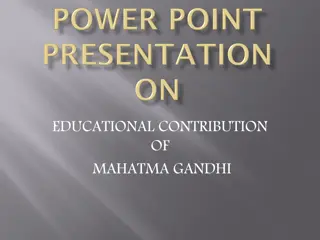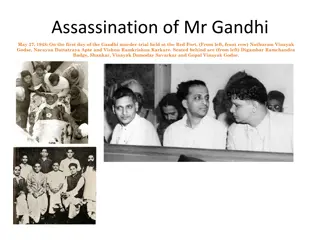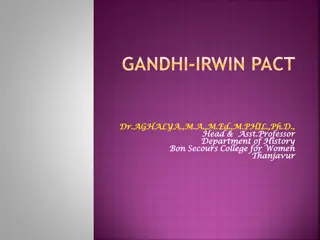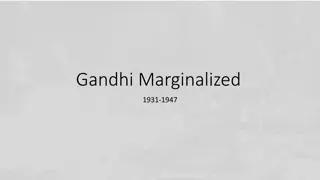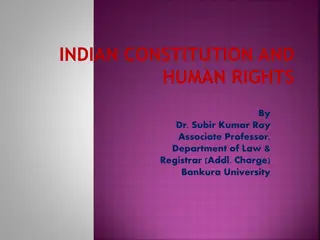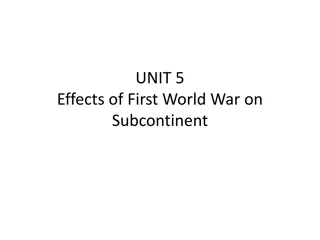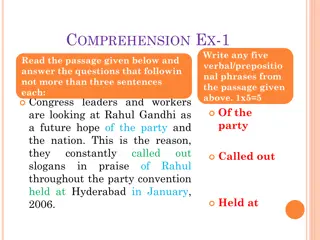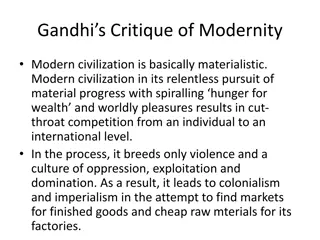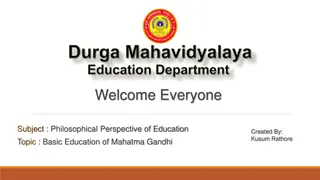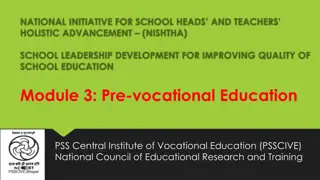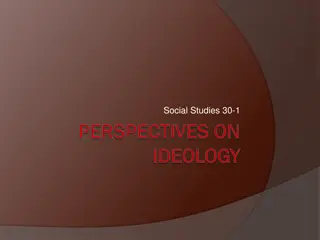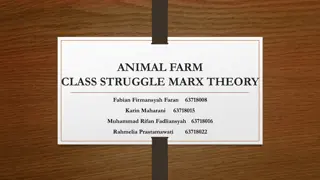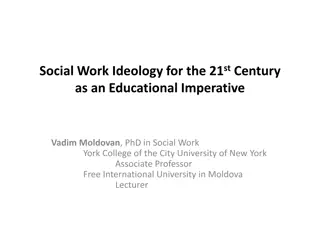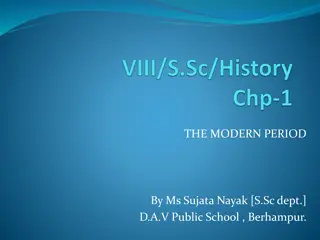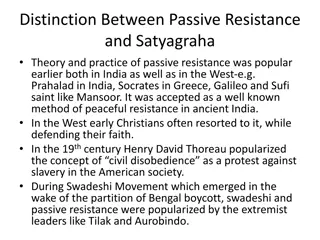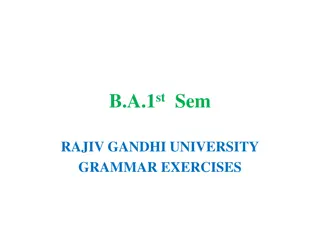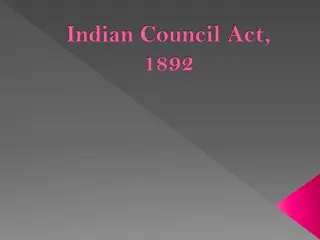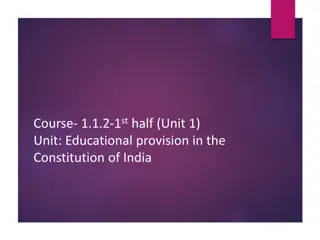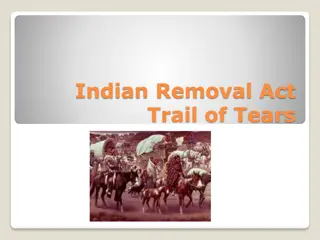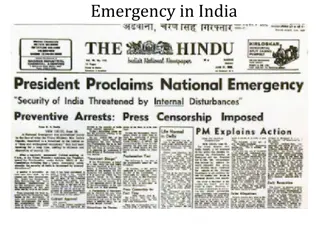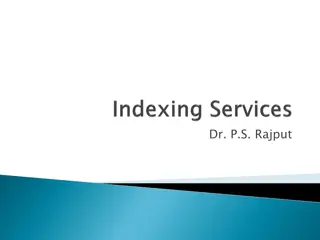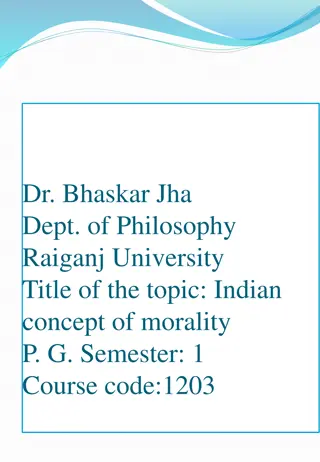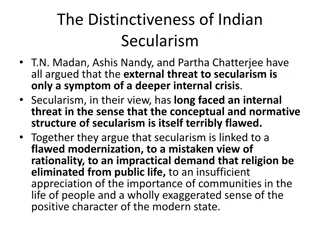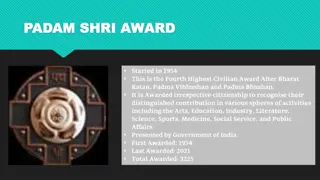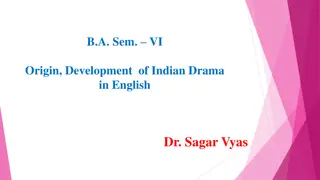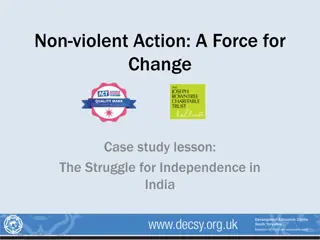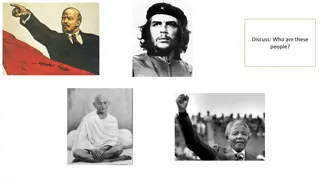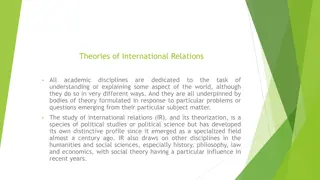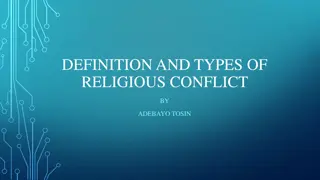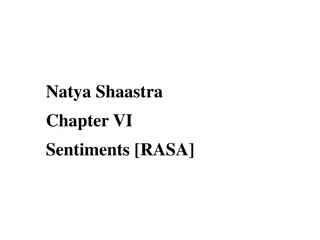Mahatma Gandhi and His Ideology in Indian History
Mahatma Gandhi, a pivotal figure in India's freedom struggle, advocated for non-violence, truth, and self-realization. He reshaped the Indian National Congress and empowered the masses to fight against injustice through civil disobedience. Gandhi's ideologies of swadeshi, local democracy, and trusteeship continue to inspire. His influence extended globally, promoting peace and spiritual values. Gandhi's legacy remains significant in shaping India's history and political landscape.
Download Presentation

Please find below an Image/Link to download the presentation.
The content on the website is provided AS IS for your information and personal use only. It may not be sold, licensed, or shared on other websites without obtaining consent from the author. Download presentation by click this link. If you encounter any issues during the download, it is possible that the publisher has removed the file from their server.
E N D
Presentation Transcript
Gandhi and his Ideology Ms. Brighty Robert PG Department of History
P.G. Department of History CARMEL COLLEGE, MALA Gandhian Ideology Mohandas Karamchand Gandhi (1869-1948) Most authentic and celebrated representative of the wisdom and culture of India in our times. Address him, with respect, as the Mahatma. A social reformer, an economist, a political philosopher and a seeker of truth. We consider him as a 'yugapurusha', one who inaugurated a new era. The contribution of Mohandas Karamchand Gandhi to the Indian national movement was un-paralleled. He made the Indian National Congress a peoples' Congress and the national movement a mass movement. He made people fearless and bold and taught them the non- violent method for fighting against injustice. He had a passion for individual liberty which was closely bound with his understanding of truth and self realization.
Against the evils of industrialization, materialism and selfish pursuits, Gandhi suggested, in , turn, swadeshi, primacy of the self and trusteeship; Against the institution of state, as the force personified, and the prevalent notion of democracy where only heads are counted, he - favored a swaraj type of democracy which give importance to the local level. Pursuit of Truth is his mantra and non-violence was integral to it. Gandliiji's notable writings : An Autobiography: The Story, of' My , Experiments with Truth; The Collected Works of Mahatrna Gandhi; Panchayati Raj; Sarvodaya and Hind Swaraj. He edited Young India which he later renamed as Harijan which remained his mouthpiece. Gandhi was also influenced by many: Tolstoy (Gospels in Brief; What to Do, The Kingdoms of God is Within You), Ruskin (Unto This Last), Thoreau (Civil Disobedience), Swami Vivekananda, Gokhale and Tilak, just to mention a few
Role of Mahatma Gandhi in Indian Freedom Struggle is considered the most significant as he single-handedly spearheaded the movement for Indian independence. The peaceful and non-violent techniques of Mahatma Gandhi formed the basis of freedom struggle against the British yoke. Gopal Krishna Gokhale, who led the Congress party, introduced Mahatma Gandhi to the concerns in India and the struggle of the people. Ideology of Gandhiji Non Violence The non-violence is the most ancient eternal value. This non-violence is the ground of ancient-most civilization and culture of India. Mahatma Gandhi said on this very account while making his concepts and practices based on non-violence: I have nothing new to teach you Truth and nonviolence are as old as hill. As we know, non-violence and truth are two sides of the same coin. After knowing Gandhism, it is imperative for us to know clearly the concept of nonviolence also as it accords the ground for Gandhism
Gandhis importance in the political world scenario is twofold. First, he retrieved non-violence as a powerful political tool Secondly, manifestation of a higher spiritual goal, culmination in world peace For Gandhi, means were as important as the end and there could be only one means - that of nonviolence. According to Gandhi, total nonviolence consists in not hurting some other one s intellect, speech or action per own thought, utterance or deeds and not to deprive some one of his life. The principle of nonviolence is shattered by every evil thought, false utterance, hate or wishing something bad unto someone. It is also shattered per possession of necessary worldly things.
The principle of nonviolence is shattered by every evil thought, false utterance, hate or wishing something bad unto someone. It is also shattered per possession of necessary worldly things. Mahatma Gandhi clarified in an edition of Young India: To hurt someone, to think of some evil unto someone or to snatch one s life under anger or selfishness, is violence. The ultimate yardstick of violence or non-violence is the spirit behind the action. There are many examples of their use like resistance, non-violent resistance, and civil revolution. Mahatma Gandhi had to struggle in his whole life, but he never disappointed, he continued his innate faith in non-violence and his belief in the methods of Satyagraha. The significance of Satyagraha was soon accepted worldwide. Martin Luther King adopted the methods of Satyagraha in his fight against the racial discrimination of the American authorities in 1950.
Truth and Non-violence is not meant for individuals alone but can be applied in global affairs. Gandhi s vision for the country and his dreams for the community as a whole still hold good for India. SATYAGRAHA AND AHlMSA Truth or Satya, for Gandhiji, is God himself. He therefore changed the statement, "God is Truth", later in his life into, "Truth is God" and suggested that it was one of the fundamental discoveries of his life's experiments. According to Gandhiji, truth is what the inner self experiences at any point of time; it 'is an answer to one's conscience; it is what responds to one's moral self. He was convinced that knowledge alone" leads a person to the truth while ignorance takes one away from the truth. Satyagraha means urge for Satya, or truth.
Satyagraha is not merely the insistence on truth; it is, in fact, holding on to truth through ways which are moral and non-violent; It is a moral weapon and does not entertain ill-feeling towards the adversary; it is a non-violent device and calls upon its user to love his enemy. it does not weaken the opponent but strengthens him morally; it is a weapon of the brave and is constructive in its approach. For Gandhiji, a Satyagrahi is always truthful, morally imbued, non-violent and a person without any malice; he is one who is devoted to the service of all.
Truth, he firmly believed, can be attained only through non-violence which was not negative, meaning absence of violence, but was positively defined by him as love. In its positive sense, non-violence means love for others; in its negative sense, it seeks no injury to others, both in words as well as deeds. Gandhiji talked of non-violence of different people. There is the non-violence of the brave: one has the force but he does not use it as a principle; there is the non- violence of the weak: one does not have faith in non- violence, but he uses it for attaining his objectives; there is the nonviolence of the coward: it is not non-violence, but impotency, more harmful than violence. For Gandhiji, violence was a better option than cowardice.
Through non-violence one appeal to the truth that nestles in people and makes the latter realize it in themselves, come around, and join hands in the common march to truth along with those whom they earlier considered as their adversaries. Given the enmeshing of means and ends, Gandhiji, often saw Love, Truth, God and Non-violence as interchangeable terms. Truth or God or Self- realization being man's ultimate goal in life, this goal can be attained only through non-violence or ahimsa.
Champaran in the Tirhut division of North Bihar had been seething with agrarian discontent for some time. European planters had established indigo farms and factories in Champaran at the beginning of the 19th century. By 1916-17, a large part of Champaran was held by three proprietors, the Bettiah, Ram Nagar and Madhuban estates. Bettiah was the largest estate consisting of over one and half thousand villages. Most of these villages were not managed by landlords but were leased to thikadars or temporary tenure holders, of whom the most influential group was European indigo planters. The basic issue of the trouble was the system of indirect cultivation whereby peasants leased land from planters, binding themselves to grow indigo each year on specified land in return for an advance at the beginning of the cultivation season.
Indigo was cultivated under the system called Tinkathia by which a tenant had to cultivate indigo at three- twentieths of his holdings. system was made in Tinkatiya system in 1908 it did not bring any material change in the degrading conditions of the tenants. Planters always forced Planters always forced them to sell their crop for a fixed and usually uneconomic price. At this time the demand of Indian indigo in the world market was declining due to the increasing production of synthetic indigo in Germany. The planters tried to save their own position by facing the tenants to bear the burden of their losses. They offered to release the tenants from growing indigo if the latter paid compensation or damages.
Gandhi took no interest in the case of indigo cultivators of Champaran when this question was discussed at the Lucknow session of the Congress in 1916 on the ground that he knew nothing about the matter. Gandhi arrived in Bihar and started making investigations in person. When he reached Motihari, the headquarters of the district of Champaran, he was served with an order to quit Champaran as he was regarded a danger to the publicpace. Gandhi decided to disobey the order 'out of a sense of public responsibility. He was immediately arrested and tried in the district court.
The Government appointed Champaran Agrarian Committee with Gandhi as one of its members. The committee unanimously recommended the abolition of Tinkathia system and many illegal exactions under which the tenants groaned. The enhanced rents were reduced, and as for the illegal recoveries, the committee recommended 25% refund. The major recommendations of the Committee were included in the Champaran Agrarian Act of 1917 . In this agitation, the chief supporters of Gandhi came from the educated middle class. For instance, Rajendra Prasad, Gorakh Prasad, Kirpalani and some other educated persons from the cities worked as his close associates. Local Mahajans traders and village Mukhtars (attorneys) is also helped him. But i t was the peasantry which gave him the real massive support. And he approached them in a most simple and unassuming manner. In the countryside, he often walked on foot or travelled in a bullock cart. He came where ordinary people lived and talked in the language they understood.
Ahmadabad Mill Strike Gandhi organised the third campaign in Ahmedabad where he intervened in a dispute between the mill owners and workers. Ahmedabad was becoming the leading industrial town in Gujarat. But the mill owners often faced scarcity of labour and they had to pay high wages to attract enough mill hands. In 1917 plague outbreak made labour shortage more acute because it drove many workers away from Ahmedabad to the countryside. To dissuade the workers from leaving the town, the mill owners decided to pay 'Plague Bonus' which was sometimes as high as 75% of the normal wages of the workers
After the epidemic was over, the mill owners decided to discontinue the Plague Bonus. But the workers opposed the employers move and argued that it was helping them to offset the war time rise in the cost of living. The mill owners were prepared to give 20% increase but the workers were demanding a 50% raise in the wages in view of the price hike. Gandhi knew Ambalal Sarabhai, a mill owner, as the latter had financially helped Gandhi's Ashram. Moreover, Ambalal's sister. Anasuya Sarabhai had reverence for Gandhi. Gandhi discussed the workers problems with Ambalal Sarabhai and decided to intervene in the dispute.
Gandhi was included in the board as representing the workers. But, suddenly the mill owners decided to withdraw from the board on the ground that Gandhi had no real authority or mandate from the workers, and that there was no guarantee that workers would accept the arbitration award. They declared the lockout of the Mills from 22 February 1918. In such a situation, Gandhi decided to study the whole situation in detail. He went through a mass of data concerning the financial state of the mills and compared their wage rates with those of Bombay. Finally he came to the conclusion that the workers should demand 35% 'instead of 50% increase in their wages. Gandhi began the Satyagraha movement against the mill owners. The workers were asked to take a pledge stating that they would not resume work without 35% increase and that they would remain law abiding during the lockout. Gandhi, assisted by Anasuya Sarabhai organised
The mill owners ended the lockout on 12 March and announced that they would take back the workers who were willing to accept 208 increases. On the other hand, Gandhi announced on 15 March that he would undertake a fast until a settlement was reached. Gandhi's object was to rally he workers who were thinking of joining the mills despite their pledge. The fast created tremendous excitement in Ahmedabad and the mill owners were compelled to negotiate. A settlement was reached on 18 March. According to this agreement, the workers on their first day would receive 35% raise, in keeping with their pledge. On the second day, they would get 20% increase, offered by the mill owners. From the third day until the date of an award by an arbitrator, they would split the difference and receive 27 % increases. Finally the arbitrator's award went in favor of the' workers and 35%raise was given to them.
Rowalatt Act During the years 1917 and 1918 Gandhi took little interest in all lndia issues. He protested against internment of Annie Besant, and also demanded the release of Ali brothers (Mahomed Ali and Shaukat Ali) who were actively associated with the Khilafat issue. They were political leaders of the time; Gandhi did not take active interest in the Reform proposals. But it was the British decision to pass 'Rowlatt Act' which forced him to plunge into national politics in a forceful manner
In 1917 the Government of lndia had appointed a committee under the chairmanship of Justice Sydney Rowlatt to investigate revolutionary crime" in the country and to recommend legislation for its suppression. After a review of the situation, the Rowlatt committee proposed a series of change in the machinery of law to enable the British government to deal effectively with the revolutionary activities. In the light of these recommendations the Government of India drafted two bills and presented them to the Imperial Legislative Council on 6 February 1919. The government maintained that the bills were 'temporary measures' which aimed at preventing 'seditious crimes'. They provided trial of offences by a special court consisting of three high court judges. There was no provision of appeal against the decision of this court which could meet in camera and take into consideration evidence not admissible under the Indian Evidence Act. The bill also proposed to give authority to the government to search a place and arrest a person without a warrant. Detention without a trial for maximum period of two years was also provided in the bills. The bills were regarded by nationalist leaders as an effort to conciliate a section of official and non-official white opinion which had resented Montagu's Reform proposals.
A Satyagraha Sabha on 24th February 1919 in Bombay to protest against the Rowlatt Bills. Its members signed a pledge to proclaim their determination "to refuse civilly to obey these laws (i.e., the Rowlatt Bills) While launching the Satyagraha agitation against the Rowlatt bills Gandhi said: "It is my firm belief that we shall obtain salvation only through suffering and not by reforms dropping on us from the English they use brute force, we soul force. A group of liberals like Sir D.E. Wacha, Surendranath Banerjee, T.B. Sapru and Srinivas Sastri opposed Gandhi's move of starting Satyagraha. Their reason for opposing the Satyagraha was that it would hamper the Reforms. Some of them also felt that the ordinary citizen would find it difficult to civilly disobey the Act. Annie Besant also condemned the Satyagraha on the grounds that there was nothing in the Act to resist civilly, and that to break laws at the dictate of others was ' exceedingly dangerous. But the younger and radical elements of Annie Besant's Home Rule League supported Gandhi: They formed the main cadre of Satyagraha movement in different parts of the country.
In organizing this Satyagraha, Gandhi was also assisted by certain Pan- Islamic Leaders, particularly Abdul Bari of Firangi Ulema group at Lucknow, and some radical members of the Muslim League. M.A. Jinnzh also opposed the Rowlatt Bill vehemently and warned the Government of the dangerous consequences if the government persisted in clamping on the people of India the "lawless law". Gandhi inaugurated his Satyagraha by calling upon the countrymen to observe a day of 'hartal' when business should be suspended and people should fast and pray as a protest against the Rowlatt Act. The date for the 'hartal' was fixed for 30th March but it was changed to April 6th. The success of hartal varied considerably between regions and between towns and the countryside. In Delhi a hartal was observed on 30th March and ten people were killed in police firing. Almost in all major towns of the country, the hartal was observed on the 6th April and the people responded enthusiastically..
Montague chelmsford Reforms. The Montagu Chelmsford Reforms or more briefly known as Mont-Ford Reforms were reforms introduced by the British Government in India to introduce self- governing institutions gradually to India. The reforms take their name from Edwin Samuel Montagu, the Secretary of State for India during the latter parts of World War I and Lord Chelmsford, Viceroy of India between 1916 and 1921. The reforms were outlined in the Montagu-Chelmsford Report prepared in 1918 and formed the basis of the Government of India Act 1919. Indian nationalists considered that the reforms did not go far enough while British conservatives were critical of them.
In late 1917, Montagu went to India to meet up with Lord Chelmsford, the Viceroy of India, to meet with leaders of Indian community to discuss the introduction of limited self government to India and protecting the rights of minority communities. The Report went before Cabinet on 24 May and 7 June 1918 and was embodied in the Government of India Act of 1919. These reforms represented the maximum concessions the British were prepared to make at that time. The franchise was extended, and increased authority was given to central and provincial legislative councils, but the viceroy remained responsible only to London.
The changes at the provincial level were significant, as the provincial legislative councils contained a considerable majority of elected members. In a system called "dyarchy," the nation-building departments of government agriculture, education, public works, and the like were placed under ministers who were individually responsible to the legislature. The departments that made up the "steel frame" of British rule finance, revenue, and home affairs were retained by executive councillors who were nominated by the Governor. They were often, but not always, British and who were responsible to the governor. In 1921 another change recommended by the report was carried out when elected local councils were set up in rural areas, and during the 1920s urban municipal corporations were made more democratic and "Indianized.
The main provisions were the following: 1. The secretary of state would control affairs relating to Government of India 2. The Central Legislature would comprise two chambers- The Council of State and the Indian Legislative Assembly 3. The Central Legislature was empowered to enact laws on any matter for whole of India. 4. The Governor General was given powers to summon, prorogue, dissolve the Chambers, and to promulgate Ordinances. 5. The number of Indians in Viceroy's Executive Council would be three out of eight members. 6. Establishment of unicameral Provincial Legislative councils. 7. Dyarchy in the Provinces- 1. Reserved subjects like Finance, Law and Order,army,police etc. 2. Transferred subjects like Public Health, Education, agriculture,local self government etc. There would henceforth be direct election and an extension of Communal franchise.


